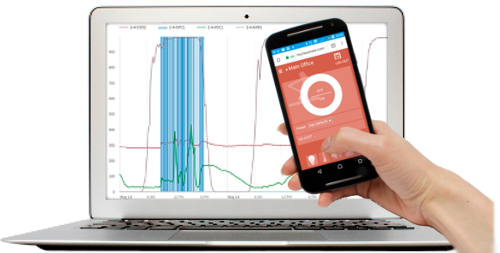
The UK government has published a consultation document for its Future Homes policy, which is intended to update the building regulations covering energy efficiency...
Cutting domestic carbon emissions is essential to achieving net-zero by 2050. Current policy is to renovate existing buildings to energy performance certificate (EPC) band C. However, that does not measure carbon emissions so every building could achieve band C and still leave the sector far short of net-zero. Here’s why.

The plan is to make the British economy net-zero in terms of carbon emissions by 2050.
The question is what that means in practical terms.
The answer depends on which sector of the British economy we’re talking about. Different sectors require different plans with different targets. For the building sector, the Department for Business, Energy and Industrial Strategy (BEIS) set the target of reducing operational carbon emissions by 98-100% by 2050 in its Clean Growth Strategy.
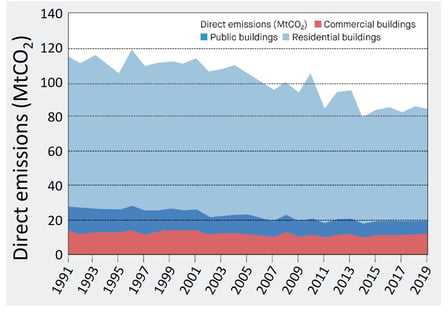 |
|
Figure 1: Trends in direct carbon dioxide emissions from commercial, public and residential buildings in the UK. Source: Kris Hudson writing in Construction Management. |
Yet that is only a partial answer. Decarbonising the building sector can only be achieved by decarbonising the buildings within the sector, which means that net-zero needs to be defined for every building that will be standing by 2050.
The burden of decarbonising buildings falls mostly on residential buildings simply because the residential sector accounts for the large majority of British buildings and hence emissions from the building sector. Carbon emissions from domestic buildings have been falling throughout the last decade, largely because electricity generation has been replacing fossil fuels with renewable sources, but it will need to fall much faster to achieve net-zero by 2050 (Figure 1).
Regulations require new buildings to be designed for low energy requirements but by 2050, those new buildings will only make up a relatively small amount of the British domestic building stock. Most of the buildings that will be standing by 2050 are already standing, and many have been standing for decades or even centuries, meaning that they predate any requirement to limit their heating energy and will need to be renovated to achieve the net-zero target.
That requirement has raised a problem epitomised by an Inside Housing survey of social landlords’ plans to renovate their stock to net-zero. There was no shortage of will; more than a fifth of respondents aimed to complete renovations before the government deadline. However, only 22% were able to produce a cost estimate, suggesting that most had no clear idea of what they needed to do.
The confusion is not helped by contradictory interim targets which, as the summary of those targets shown in Figure 2 shows, are not always harmonised even among documents published by the same department and the Scottish government aims to beat the UK to net-zero by five years.
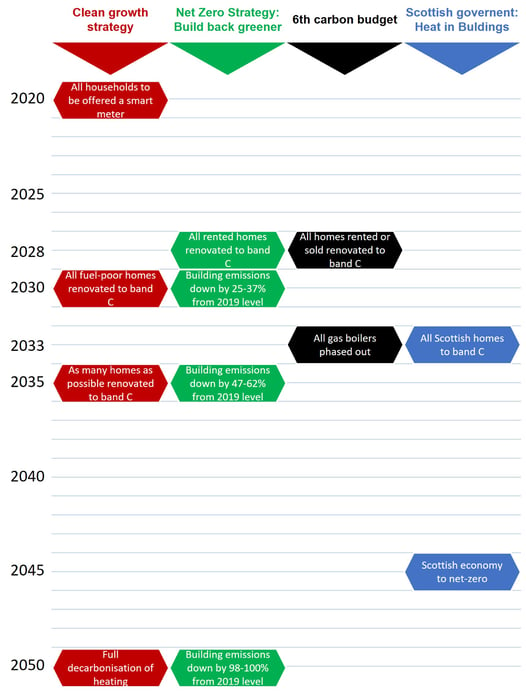 |
|
Figure 2: Key interim deadlines en route to the British economy reaching net-zero by 2050, defined in the DBEIS’s Clean Growth Strategy, DBEIS’s Net Zero Strategy, CCC’s Sixth Carbon Budget and the Scottish government’s Heat in Buildings Strategy. |
At Atamate, our view is that a clear definition of net-zero that can be applied to an individual building is required, and that definition should be based on the most direct measurement of a building’s carbon emissions available. Any assessment of that definition should have two purposes:
The second purpose is important because most of the buildings that will make up Britain’s housing stock have already been built and many have been standing since long before energy conservation was a design priority. Those buildings will need to be renovated to reduce their carbon emissions and the need for public funding was acknowledged in the government’s 2019 election manifesto, which allocated over £2 billion to decarbonising social housing and home upgrades.
Done properly, renovation will reduce carbon emissions without massively inflating energy bills. At the time of writing (June 2022), there’s more than enough bill inflation going on already. Done badly, renovations will cost large amounts of money and add to buildings’ embodied carbon link without impacting their energy use and hence their carbon emissions.
That’s why getting the initial assessment right is so important and our concern is that several recent government documents and the Sixth Carbon Budget published by the Climate Change Committee (CCC) suggest interim targets that do not use such a measure. While the targets for the building sector as a whole are framed in terms of emission reduction, the targets for individual buildings use the building’s Energy Performance Certificate (EPC) which is in no way a measurement of a building’s emissions.
Our view is that the building’s EPC is a poor proxy for direct measurements. When planning renovations or assessing their impact, far better metrics are available.
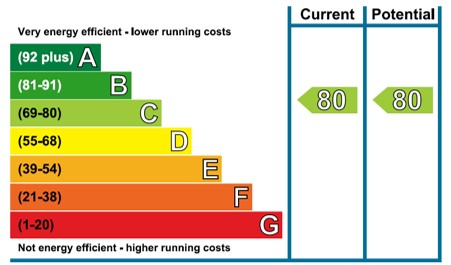 |
|
Figure 3: An energy performance certificate showing a band C rating. |
To understand our beef with EPC-based net-zero targets, it’s necessary to understand what the EPC is and, by extension, what it is not.
The EPC is one of several measures calculated as part of the Standard Assessment Procedure (SAP) for new buildings or, more relevant to renovations, the reduced SAP (RdSAP) used for existing buildings. It generates a score based on the expected cost of the energy used by the building and based on that score, the building is assigned to a band with band A being the most efficient and band G the least to produce the sort of report shown in Figure 3. As shown above, the interim targets for net-zero are based on bringing all buildings to band C by 2035, excepting only those where it is not possible.
The EPC is not, and was never intended to be, a measure of the carbon emissions associated with that building. The RdSAP methodology also includes an environmental impact rating (EI) and a dwelling emission rate (DER), both of which offer a direct prediction of the carbon emissions associated with a building. Why a rating based on the EPC, which is based on cost, has become an interim target for net-zero, which is based on carbon emissions, is something of a mystery but there are several problems with using it as such:
As the EPC was never intended to predict a building’s carbon emissions, it’s perhaps unsurprising that it does not predict them very well. The London Energy Map Project, an attempt to establish a building-by-building map of energy use in London, found almost no relationship between EPC band and carbon emissions (Figure 4).
The lack of correlation between EPC band and carbon emissions is a fundamental problem with using the EPC to measure progress toward a goal defined in terms of carbon emissions.
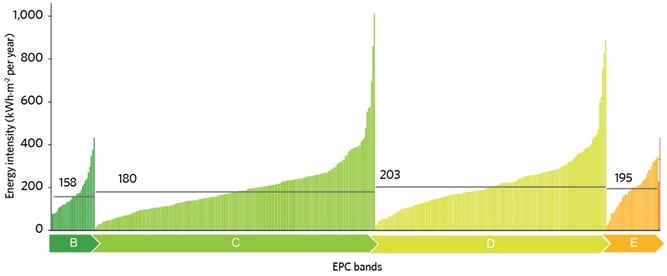 |
|
Figure 4: Energy consumption per area of 420 London homes sorted by EPC band. Source: London Energy Map published in CIBSE Journal. |
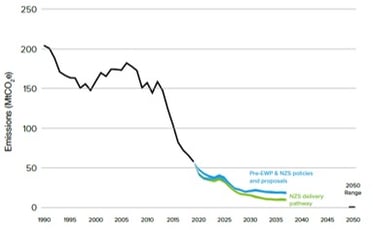 |
|
Figure 5: UK carbon emissions produced by electricity generation 1990-2020 with projections to according to the government’s Net-Zero Strategy, which do not appear to match the stated goal of full decarbonisation of grid electricity by 2035. |
Any realistic net-zero target needs to address the fact that 86% of English homes depend on gas-powered central heating [PDF], a figure unlikely to differ substantially between the UK nations, and burning gas inevitably emits carbon dioxide. Moving buildings to electrical power is central to the DBEIS’s Net-Zero Strategy because the national grid is transitioning from fossil fuel to renewables, which has led to a 66% reduction in emissions since 1990 [PDF] and the net-zero strategy states, ‘we will fully decarbonise our power system by 2035’. However, it is not stated whether the decarbonisation incorporates the carbon emissions associated with construction and maintenance or only refers to direct generation and the same document contains a plot that projects a substantial reduction in emissions by 2035 but not full decarbonisation (Figure 5).
Leaving the specifics of the projections to one side, electricity already delivers power at an estimated 0.136 kgCO2e/kWh which makes it a far lower carbon option than mains gas’s 0.21 kgCO2e/kWh [PDF] so transitioning buildings from gas to electricity will substantially reduce their carbon emissions even though mains electricity is still far from decarbonised. We have discussed the challenge of managing the transition from low-cost, high-carbon gas to high-cost, low-carbon electricity in depth elsewhere because meeting that challenge is central to decarbonising the building sector. An attempt to meet that challenge is actively hindered by targets based on the EPC because, being based on cost rather than emissions, gas power is always going to score higher than an equivalent system using electrical power.
Our experience is that installing an electrical boiler makes it almost impossible for a building to achieve a band C rating. As a net-zero target, band C is not so much unhelpful as actively counter-productive.
Basing a target on a building’s EPC incentivises its owner to find the cheapest way to raise a building to band C rather than considering how best to minimise its carbon emissions. For example, improving the insulation in one wall may improve a building’s EPC rating even if all it does is redirect heat loss through another that remains uninsulated, delivering little or no reduction to the building’s heat requirement.
Whether such approaches arise from owners deliberately gaming the system or from good-faith pursuit of a strategy in which targets are not aligned with objectives, the result will be the same: unnecessary expenditure and an increase in a building’s embodied carbon with little or no effect on its carbon emissions.
Until relatively recently, government and CCC documents referred to energy efficiency in terms of the building’s size, usually measured in terms of the floor area. In 2019, the CCC’s 2019 report on UK housing recommended that new buildings should have a space heating demand lower than 20kwh/m2/yr and ideally should be below 15kwh/m2/yr as required by for Passivhaus certification, and the CCC’s views were repeatedly referenced in the government’s Future Homes consultation on updating housing regulations published later in 2019.
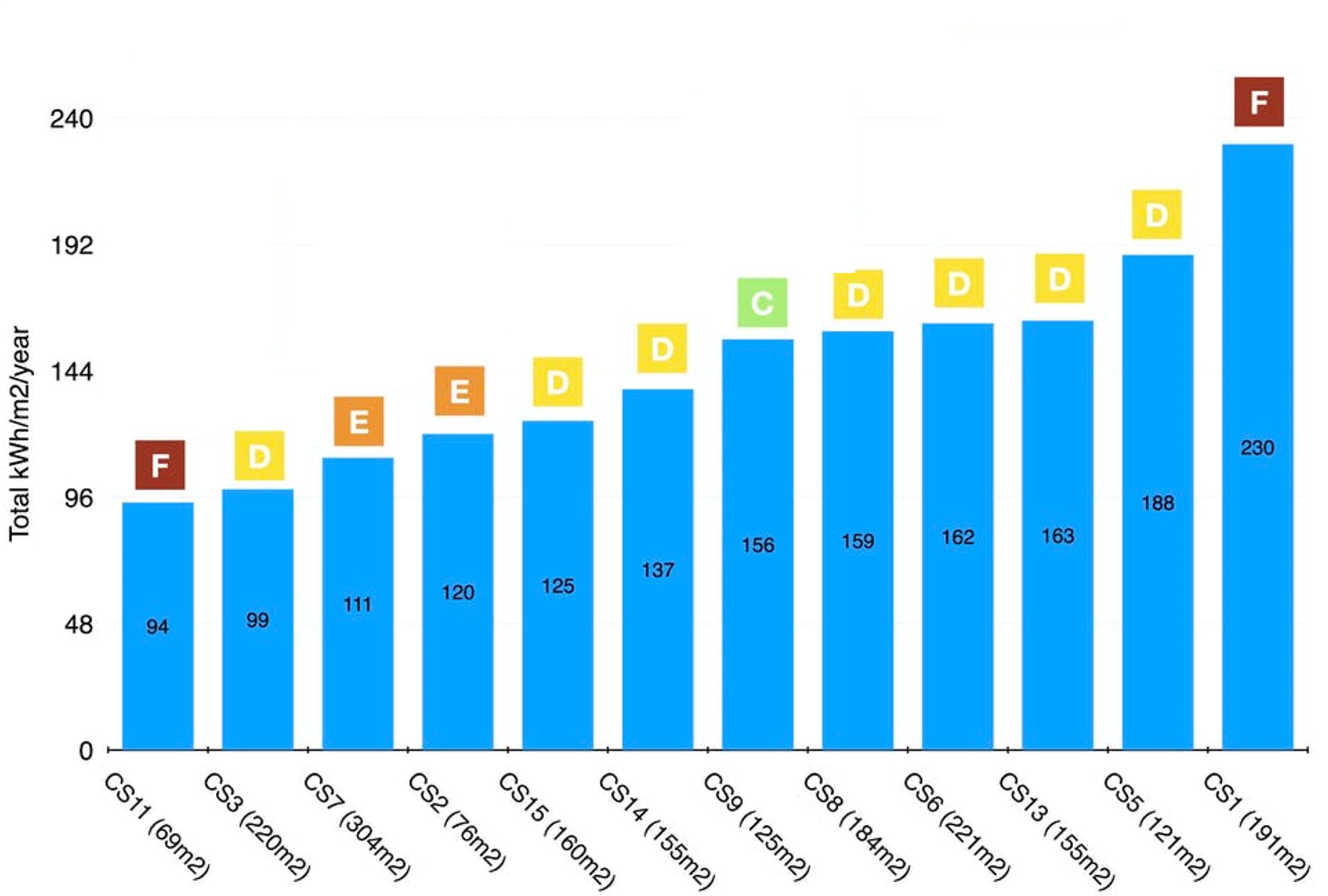 |
|
Figure 6: Energy consumption by 14 pre-1945 buildings in Northwest England compared to their EPC bands. Source: Freya Wise writing in The Conversation. |
The disconnect between the two approaches to measurement has been highlighted by Freya Wise, who ranked the energy use of 12 pre-1945 buildings in Northwest England. Most of the buildings fell into bands D and E, while the two that fell into band F were those with the highest and lowest energy use while the only one to achieve band C was squarely in the middle (Figure 6). While Wise’s analysis was of energy use rather than carbon emissions, it’s unlikely that pre-1945 buildings differed dramatically in their energy sources.
Neither the relevant government departments nor the CCC have explained why their recent strategy documents have seen EPC bands replace the direct measurements of energy consumption per floor area but our view is that it is a step in the wrong direction.
There is another factor that is not captured in EPCs and, in our view, it is a factor that is overlooked far too often in assessments of building energy consumption: the building’s occupants who are, after all, the factor that consumes the energy.
Many low-income families live in homes that are both poorly insulated and relatively crowded. The poor insulation is likely to leave those homes with a worse EPC rating than, for example, a reasonably affluent retired couple living in a well-insulated home sized for their children who have now left home. However, the low-income family may well be consuming far less energy per person than the retired couple.
Moreover, a Loughborough University study of homes in Leicester showed considerable variation in how people use energy in their homes. Residents operated their heating systems in very different ways and even within the same house, many people augmented their central heating with gas fires or electric heaters which drove very different patterns of temperature fluctuation in different rooms (Figure 7). The authors’ over-arching conclusion was that ‘the dwelling type, age and construction had much less impact on the measured temperatures than did the characteristics of the occupants’.
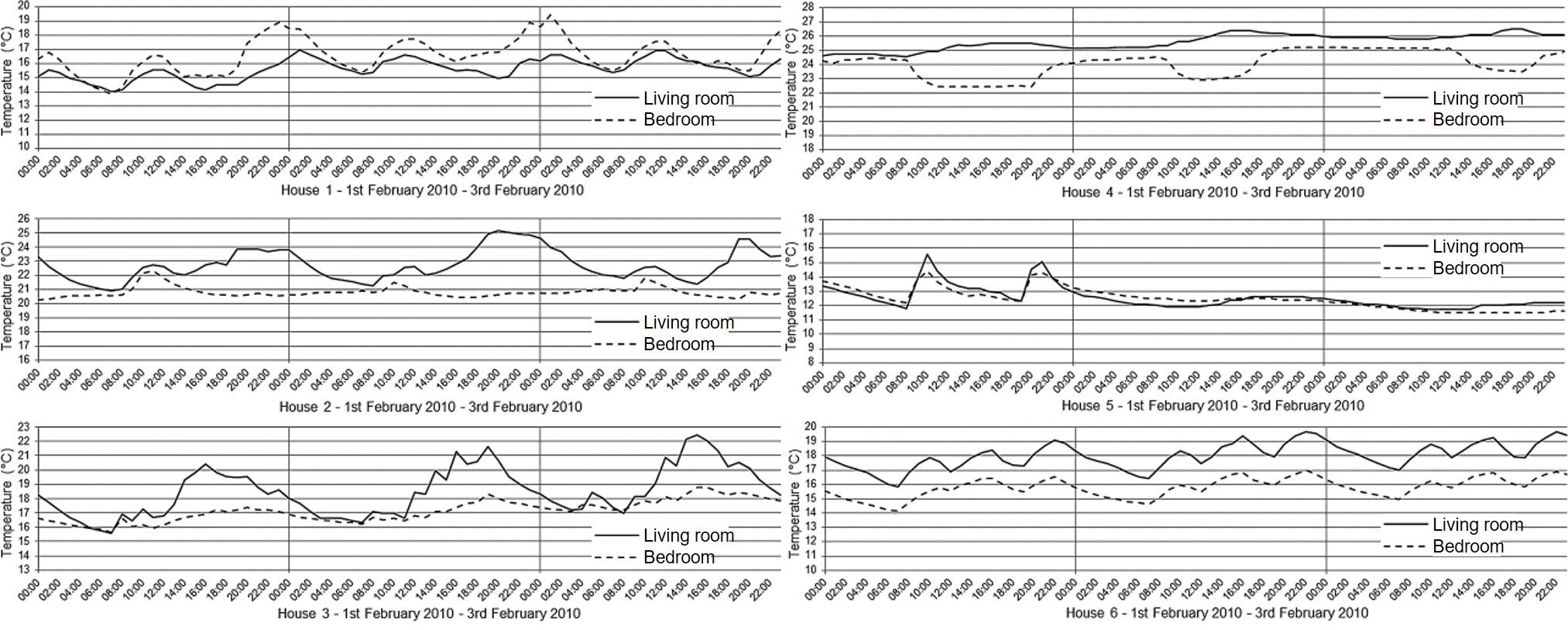 |
|
Figure 7: Different diurnal patterns of temperature change in the living rooms and bedrooms of six selected Leicester homes. Source: Kane et al (2015). |
Yet type, age and construction are what the EPC evaluates. It does not even try to capture the complexities of human behaviour and it’s not likely to succeed if it tried. There are simply too many factors and few of them are fixed: employed people lose their jobs, unemployed people find jobs, babies are born and need someone at home to look after them until they start going to school and school children grow up and become either employed or unemployed…and so on. Nor does it consider appliances, like the electric heaters and gas fires that so many of the residents used.
Trying to predict human behaviour and how it will impact energy consumption is impossibly complex, which is perhaps the best argument to not try but instead to base assessments on measurements of the energy that is used.
The objections to using the EPC rating would be moot if it were the best available measure but in the sort of occupied home that would be assessed by RdSAP, there are better approaches to assessing its energy efficiency. The EI and DER calculated by RdSAP offer direct predictions of a building’s emissions which make them more relevant to the net-zero target than its EPC rating but there are still methods for predicting emissions that can be replaced with direct measurement.
According to the clean growth strategy, every household was supposed to have been offered a smart meter by the end of 2020 [PDF], which would provide a direct measure of gas and electricity use. That target was almost certainly missed by a country mile; the last English Housing Survey found that only 34% of households had any sort of smart meter installed by the end of 2019 [PDF] and it’s hardly likely that the energy suppliers, who are responsible for installing smart meters, have made up the backlog during the COVID-19 pandemic while many of those suppliers were driven into bankruptcy by rising gas prices.
As we reported in 2018, the smart meter programme has been a tale of missed deadlines and misaligned incentives from the start, to the extent that one of the government’s own reports [PDF] agreed with the assessment of Martin Lewis of MoneySavingExpert.com, who called it a ‘cock up and a catastrophe’.
Nevertheless, getting smart meters into homes remains a priority in UK energy policy and every home with a smart meter installed should have a direct measure of its gas and electricity consumption. Given that its floor area should be on record from any SAP or RdSAP, it would not be difficult to convert that into a measurement in kWh/m2/yr as the CCC advocated in 2019.
It should also be possible to factor in the number of people living in the home using electoral register data – if only those smart meters were actually installed.
Smart meters measure energy use that can be converted into carbon emissions, but the sort of building-wide – or at least dwelling-wide – assessments given by EPCs or smart meters are unlikely to provide enough detail to plan the most cost-efficient renovation.
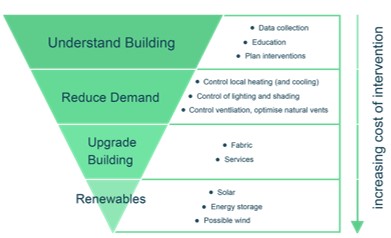 |
|
Figure 8: The Atamate energy hierarchy, a template for renovating an existing building for better energy performance. |
Our approach, discussed in detail in our white paper on renovating for net-zero [PDF], is based on what we call the Atamate energy hierarchy (Figure 8): a thorough understanding of the building enables renovations to be targeted to where they will pay for themselves. That understanding is provided by sensors [PDF] that provide a multifactorial picture of the environment in each room, encompassing parameters including air quality, temperature and occupancy. Data on the building’s internal environment is combined with data from metering gas and electricity use in the building and can be augmented with infra-red imaging to identify where heat energy is lost from the building.
That information is then used to target renovations, prioritising low-cost high-return ‘simple wins’ that usually relate to the way the services are used. For example, installing thermostatic radiator valves and placing them under automated control is a minor modification that can substantially reduce the energy a central heating system wastes on empty rooms.
In most existing buildings, fabric upgrades are required but where a dwelling-wide assessment might conclude that the entire building envelope needs to be insulated, data-based understanding identifies where heat energy is being lost and target insulation or prevention of air leakage to those places. Higher cost interventions like installing solar panels are only considered in terms of their predicted payback time.
Some of the simple wins and targeted upgrades may have a substantial impact on a building’s energy consumption but have such a minor effect on its EPC score that they do not change the EPC grade.
In our response to the 2019 Future Homes consultation, we argued that too much emphasis was being placed on particular technologies and not enough on measuring the outcome of energy use and its associated carbon emissions. Our view is that the targets discussed by the CCC and BEIS have moved backwards since then; instead of embracing in-use measurements, they have embraced a metric that takes no account of a building’s size, energy use or indeed the carbon emissions that it forms part of a strategy intended to eliminate.
Net-zero will only be achieved for Britain if it is achieved for British buildings, and British buildings can only achieve it through renovations informed by realistic measurement of their carbon emissions. We have the tools to make those measurements and we call on the government to modify its strategy to make use of them.
If you’d like to know more about how the atBOS platform can measure a building’s carbon emissions and inform a renovation programme, ask us on the form below and we'll be happy to discuss it.

The UK government has published a consultation document for its Future Homes policy, which is intended to update the building regulations covering energy efficiency...
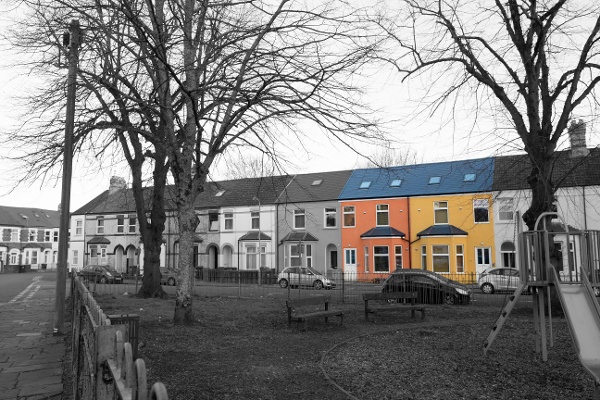
Our Senior Data Scientist, Dr Kat Kelly recently showed that rented flats using variable ventilation and direct electrical heating under Atamate smart control delivered...